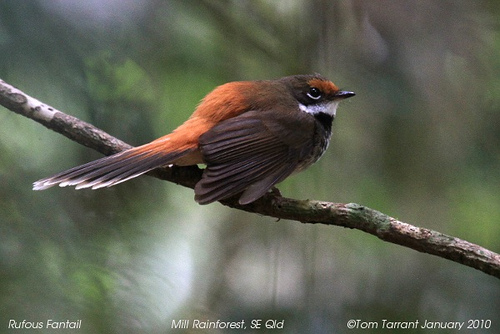Colours
Distinguishing features
The male and female of the species look identical. However, females are generally smaller than the males.
The forehead is a richly reddish-brown colour across the eyes. The eyes have a white arc just below them. The top of the head, back of the neck and the upper back, transition from an olive to reddish-brown colour, which then blends into a blackish-brown, long, fan-shaped tail. This blackish-brown tail, contrasts with the base of the tail, which is tipped with a paler colour, often white.
It has black ear-coverts (feathers over the ears, just below and behind the eyes). The throat is white (in most subspecies), and there is a black bar across the upper breast. Below this, the lower breast is off-white with black scale-like spots which transitions into an off-white colour towards the centre of the abdomen. The eyes, bill and feet of the bird are all a brown colour.
Compared to the adults, the juveniles have duller coloured backs and marginally browner tails and underparts. The base of the bill and the legs are a paler brown for juveniles relative to adults. (Wikipedia)
Size
- From 14.5 cm to 18.5 cm (Length of specimen)
Wingspan
- Wingspan data is not yet available.
Synonyms
Distribution
Distribution and habitat preferences
It can be found in Australia, Indonesia, New guinea and the Solomon Islands. In these countries they inhabit rainforests, wet forests, swamp woodlands and mangroves. (Wikipedia)
Diet
It tends to feed on small insects in the lower parts of the canopy. (Wikipedia)



